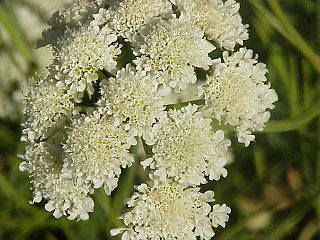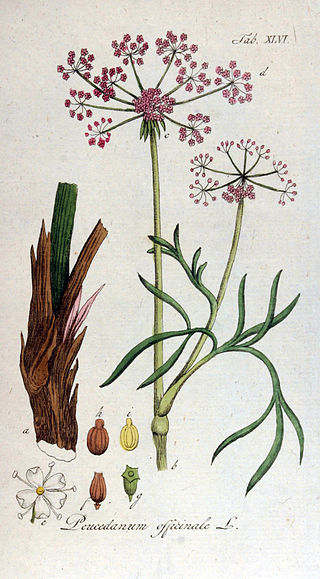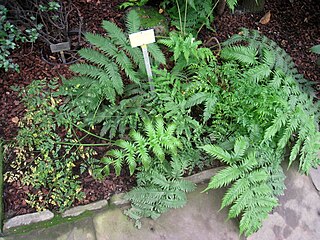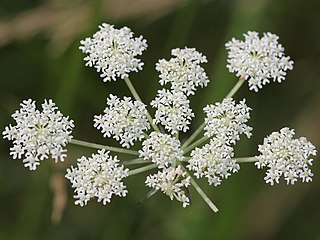
Daucus carota, whose common names include wild carrot, European wild carrot, bird's nest, bishop's lace, and Queen Anne's lace, is a flowering plant in the family Apiaceae. It is native to temperate regions of the Old World and was naturalized in the New World.

Daucus is a worldwide genus of herbaceous plants of the celery family Apiaceae of which the best-known species is the cultivated carrot. Daucus has about 75 species. The oldest carrot fossil is 1.3 Ma, and was found on the island of Madeira in the Atlantic Ocean.

Thapsigargin is a non-competitive inhibitor of the sarco/endoplasmic reticulum Ca2+ ATPase (SERCA). Structurally, thapsigargin is classified as a guaianolide, and is extracted from a plant, Thapsia garganica. It is a tumor promoter in mammalian cells.

Athamanta is a genus of flowering plant in the family Apiaceae. It is native to southern Europe and northern Africa.

Peucedanum is a genus of flowering plant in the carrot family, Apiaceae. Peucedanum boasts a global presence with diverse spread of morphological features. Peucedanum species are characterized by dorsally compressed mericarps, slightly prominent dorsal ribs, narrowly winged lateral ribs, and a broad commissure. However, the vast diversity of morphology, fruit forms, and phytochemical production makes classifying species in the Peucedanum challenging. Historically relevant in traditional medicine, Peucedanum's taxonomic complexity arises from its extensive diversity.

Laser is a genus of flowering plants in the family Apiaceae, native to Europe and southwestern Asia, from France east to the Ural Mountains in Russia and northern Iran. The genus was first described in 1799.

Athamanta montana, synonym Tinguarra montana, is a species of plants in the family Apiaceae, endemic to the Canary Islands.

Inspyr Therapeutics, Inc. is a development-stage pharmaceutical company based in San Antonio, Texas. The company is focused on therapeutics that deliver a cancer-destroying drug directly to the tumor or its supporting environment, the tumor vasculature.

Thapsia garganica is a species of flowering plant in the carrot family, Apiaceae. It is a perennial native to the Mediterranean Basin, including Portugal, Spain, Italy, Greece, Turkey, Algeria, Tunisia, and Libya.

Thapsia villosa, commonly known as the villous deadly carrot, is a species of poisonous herbaceous plants in the genus Thapsia. It grows to about 70 to 190 cm in height. It has pinnate hairy leaves with sheath-like petioles. The flowers are yellow in color and borne on compound umbels. They develop into fruits with four wings characteristic of the genus. It is native to southwestern Europe and northwestern Africa surrounding the Mediterranean Sea. The plant was used extensively for traditional medicine since around the 3rd century BC.
Daucus insularis is a species of flowering plants of the family Apiaceae. The species is endemic to Cape Verde. The species was first described by Filippo Parlatore in 1849 as Tetrapleura insularis.

Silphiodaucus prutenicus is a species of flowering plant belonging to the family Apiaceae.
Silphiodaucus is a genus of flowering plants belonging to the family Apiaceae.

Ferula assa-foetida is a species of Ferula endemic to Southern Iran. It is a source of asafoetida, but not the main source, although many sources claim so. The production of asafoetida from this species is confined to Southern Iran, especially the area near Lar.
Kozlovia is a genus of flowering plants belonging to the family Apiaceae.
Neonelsonia is a monotypic genus of flowering plants belonging to the family Apiaceae. It just contains one species, Neonelsonia acuminata, native to southern Mexico, Colombia, Costa Rica, Ecuador, Guatemala, Panamá, Peru and Venezuela. It is part of the tribe Selineae.
Rutheopsis is a monotypic genus of flowering plants belonging to the family Apiaceae. It only contains one known species, Rutheopsis herbanica(Bolle) A.Hansen & G.Kunkel

Thapsia gummifera is a species of flowering plant in the family Apiaceae, native to the western Mediterranean; Portugal, Spain, Morocco, Algeria, and Tunisia. It has been proposed as a candidate for the plant known in antiquity as silphium and gone extinct in Libya in the 5th century.

Daucus decipiens, the parsnip palmblack parsley, tree angelica, or non-stinging hogweed, is a species of plant in the family Apiaceae.
















